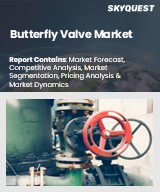
|
시장보고서
상품코드
1635166
수소 밸브 시장 평가 : 유형, 밸브 사이즈, 재료 유형, 최종사용자, 지역별 기회 및 예측(2018-2032년)Hydrogen Valve Market Assessment, By Type, By Valve Size, By Material Type, By End-user, By Region, Opportunities and Forecast, 2018-2032F |
||||||
세계의 수소 밸브 시장 규모는 2024년 3억 5,071만 달러에서 예측 기간 중 7.38%의 CAGR로 추이하며, 2032년에는 6억 1,991만 달러 규모로 성장할 것으로 예측됩니다.
수소 밸브 시장은 최근 수년간 괄목할 만한 성장세를 보였으며, 수소 인프라의 확대, 수소 연료 스테이션에 대한 급속한 투자, 탈탄소화에 대한 관심 증가로 인해 앞으로도 큰 폭의 성장이 예상됩니다. 세계 수소 밸브 시장 수요는 수소 수요 증가, 수소 생산 및 소비 촉진을 위한 정부의 구상, 청정 연료에 대한 관심 증가로 인해 증가할 것으로 예상됩니다. 수소가 청정 대체 에너지로 입증됨에 따라 이산화탄소 배출 감소에 대한 인식이 높아지면서 수소 밸브에 대한 수요가 증가하고 있습니다. 신흥 국가 및 기업은 수소의 생산, 유통 및 효율적인 저장에 효율적으로 투자하고 있으며, 이에 따라 효율적이고 신뢰할 수 있는 밸브에 대한 수요가 증가할 것으로 예상됩니다. 또한 신흥 국가 정부는 기후 변화 대응 계획의 일환으로 수소 기술 활용을 장려하는 정책을 시행하며 재정적, 비재정적 인센티브를 부여하고 있습니다. 뿐만 아니라, 각국 정부는 수소 인프라 개발에 대한 투자를 늘리고 있으며, 수소 관련 기기에 대한 수요 증가를 촉진하고 있습니다.
수소는 암모니아 제조, 정제, 연료전지 등의 산업 공정에서 널리 사용되고 있습니다. 이러한 산업에서 수소 기술의 발전과 확대, 그리고 수소 기술의 채택은 수소를 효율적이고 안전하게 취급하기 위한 특수 밸브의 필요성을 촉진합니다. 또한 시장 업체들은 수소 인프라에 요구되는 모든 안전 적합성을 충족하는 새로운 밸브의 도입을 계획하고 있습니다.
세계의 수소 밸브 시장을 조사했으며, 시장의 정의와 개요, 시장 규모 추이·예측, 각종 구분별 상세 분석, 산업 구조, 시장 성장에 대한 영향요인 분석, 사례 연구, 경쟁 구도, 주요 기업의 개요 등을 정리하여 전해드립니다.
목차
제1장 프로젝트 범위와 정의
제2장 조사 방법
제3장 개요
제4장 고객의 소리
- 제품과 시장 정보
- 브랜드 인지도
- 구입 결정시 고려되는 요소
- 프라이버시와 규제에 관한 고려
제5장 세계의 수소 밸브 시장 전망
- 시장 규모 분석·예측
- 시장 점유율 분석·예측
- 유형별
- 밸브 사이즈별
- 재료 유형별
- 최종사용자별
- 지역별
- 기업 점유율 분석(상위 5사 및 기타)
- 시장 맵 분석
제6장 북미의 수소 밸브 시장 전망
- 시장 규모 분석·예측
- 시장 점유율 분석·예측
- 유형별
- 밸브 사이즈별
- 재료 유형별
- 최종사용자별
- 국가별 점유율
- 국가별 시장 평가
- 미국
- 캐나다
- 멕시코
제7장 유럽의 수소 밸브 시장 전망
- 독일
- 프랑스
- 이탈리아
- 영국
- 러시아
- 네덜란드
- 스페인
- 터키
- 폴란드
제8장 아시아태평양의 수소 밸브 시장 전망
- 인도
- 중국
- 일본
- 호주
- 베트남
- 한국
- 인도네시아
- 필리핀
제9장 남미의 수소 밸브 시장 전망
- 브라질
- 아르헨티나
제10장 중동 및 아프리카의 수소 밸브 시장 전망
- 사우디아라비아
- UAE
- 남아프리카공화국
제11장 규제 상황
제12장 수급 분석
제13장 수출입 분석
제14장 밸류체인 분석
제15장 Porter's Five Forces 분석
제16장 PESTLE 분석
제17장 가격 분석
제18장 시장 역학
- 시장 성장 촉진요인
- 시장이 해결해야 할 과제
제19장 시장 동향과 발전
제20장 사례 연구
제21장 경쟁 구도
- 상위 5사의 경쟁 매트릭스
- 상위 5사의 SWOT 분석
- 상위 10사의 상황
- Emerson Electric Co.
- Crane Company
- KITZ Corporation
- Baker Hughes Company
- Honeywell International Inc.
- Swagelok Company
- Christian Burkert GmbH & Co. KG
- Westport Fuel Systems Inc.
- Schlumberger Limited
제22장 전략적 제안
제23장 Market Xcel - Markets and Data 소개·면책사항
KSA 25.02.12Global hydrogen valve market is projected to witness a CAGR of 7.38% during the forecast period 2025-2032, growing from USD 350.71 million in 2024 to USD 619.91 million in 2032. The market has experienced significant growth in recent years and is projected to witness prosperous growth owing to the expansion of hydrogen infrastructure, rapid investments in hydrogen fueling stations, and increasing focus on decarbonization. The global hydrogen valve market demand is projected to rise due to rising hydrogen requirements, government initiatives to boost hydrogen production and consumption, and increasing emphasis on clean fuels. The rising awareness concerning reducing carbon emissions drives the demand for hydrogen valves, as hydrogen proved to be a clean energy alternative. Emerging countries and companies are efficiently investing in hydrogen production, distribution, and efficient storage, and the requirement for efficient and reliable valves will rise. In addition, the governments of emerging countries are implementing policies and granting monetary and non-monetary incentives to encourage the usage of hydrogen technologies as part of their climate action plans. Not only this, but the government is also increasing the amount of investment in hydrogen infrastructure development, propelling the growing requirement for hydrogen-concerned equipment.
Hydrogen is widely used in industrial processes, including ammonia production, refining, and fuel cells. The advancement and expansion in these industries and the adoption of hydrogen technologies will propel the requirement for specialized valves to handle the hydrogen efficiently and safely. Moreover, companies in the market plan to introduce a new range of valves to meet all the required safety conformance for hydrogen infrastructure.
For instance, in December 2024, Christian Burkert GmbH & Co. KG announced the launch of ultra-high-pressure valves for hydrogen applications that can control hydrogen up to 1,000 bars, suitable for grid infrastructure and vehicle fueling stations.
Ongoing Technological Advancements Drive the Hydrogen Valve Market Globally
Technological advancements include integrating high-performance materials and processes to confirm stable operations under different conditions, driving the global hydrogen valve market demand in the forecast period. Automation and artificial intelligence are reshaping the global hydrogen valve market by improving the effectiveness and reliability of production procedures. Artificial integration enables predictive maintenance, reduces maintenance costs and downtime, and allows manufacturers to anticipate equipment failures, driving the global market for hydrogen valves in the forecast period. In addition, hydrogen valves embrace digitization and the trend toward intelligence, accomplishing more flexible and efficient functions. The application of high-performance materials and manufacturing technologies enables hydrogen valves to function in a comprehensive range of temperatures and pressures. This advancement in hydrogen valve technology will propel market growth in the forecast period. Furthermore, companies in the market are introducing high-performance and advanced valves for automotive and other industries to expand their market presence and product portfolio.
For instance, in March 2024, Eaton Corporation plc introduced a next-generation fuel tank isolation valve for hybrid electric vehicles to address evaporative emissions that accumulate when the gas engine is not in operation. The new fuel tank isolation valve is easier to mount as these are 27% lighter, 39% smaller, and comprises 24% fewer components than its predecessor.
Rising Concern for Renewable Energy Surges Demand for Hydrogen Valve
The rising awareness concerning renewable energy is driving the global hydrogen valve market demand as hydrogen valves are important for the efficient operation of fuel cells and ensuring proper pressure and volume for high performance. Additionally, the demand for hydrogen valves is rising owing to its diverse range of applications in the energy sector, specifically in power plants and utility systems. These valves control the pressure and flow of hydrogen within the renewable energy system to ensure efficient usage and safe operation of hydrogen. They also allow for the storage of excess energy when they are used in hydrogen storage systems within the power plants during off-peak periods. The surging demand for hydrogen valves can also be attributed to the growing adoption of hydrogen-powered generators to offer backup or off-grid power in applications where renewable energy sources may be unavailable. Companies in the market are announced to expand the product line to satisfy the rising customer requirement for hydrogen valves with larger bore sizes.
For instance, in May 2024, Acme Cryogenics Inc., part of OPW and Dover Corporation, a clean energy solution company, announced that it had developed new 6" and 8" valves for its Model CV Valve product line to meet the evolving requirements of their customers.
Hydrogen Ball Valve Dominates the Global Hydrogen Valve Market Share
Hydrogen ball valve dominates the global market for hydrogen valves owing to technological advancements, rapid investment by the governments of emerging countries in hydrogen infrastructure, and the rising adoption of hydrogen as a clean energy source. Industries are shifting towards sustainable energy solutions, and hydrogen is emerging as a key player throughout this shift. The global hydrogen ball valve market demand is projected to rise due to its significance for controlling and managing hydrogen flow in different applications. The rising awareness concerning carbon emissions, stringent government rules and regulations, and increase in pollution drive the demand for hydrogen ball valves in the hydrogen valve market in the forecast period. In addition, the technological advancements in valve materials and designs have enhanced the performance and safety of hydrogen ball valves, coupled with making them suitable for corrosive environments and high pressure, propelling the global hydrogen valve market growth in the forecast period. Furthermore, companies in the market are placing huge volume orders of ball valves for a diverse range of applications including heat production and others.
For instance, in October 2024, RWE Gas Storage West placed an order for 1400 ball valves from Hartmann Valves GmbH for a new hydrogen storage facility in Lingen. The ball valves are proposed to allow the connection of the cavern in Gronau-Epe to the planned hydrogen network.
Asia-Pacific Registers the Largest Market Share in the Global Market
Asia-Pacific holds the largest market share in the global hydrogen valve market owing to rapid industrialization and the rising requirement for clean energy sources coupled with stringent and favorable government rules and regulations. The governments of emerging countries, including Japan, India, China, and others, are significantly promoting hydrogen production and infrastructure development through incentive and supportive policies. In addition, the government is increasing its investment in hydrogen infrastructure projects, including distribution networks, production facilities, and storage systems, driving the Asia Pacific hydrogen valve market growth. Moreover, the countries in the Asia Pacific are focusing on reducing greenhouse gas emissions and shifting towards sustainable energy solutions, further fostering the requirement for hydrogen valves. The Asia-Pacific market for hydrogen valves is projected to continue its dominance owing to continuous technological advancements, strategic collaborations, and the introduction of factories within the industry.
For instance, in September 2022, Crane Company announced the inauguration of its new engineered check valve factory in Satara, Maharashtra to support the demands of a wide range of industries within the chemical processing, petrochemical, and energy sectors, including renewable energy and other evolving markets, such as hydrogen production.
Future Market Scenario (2025 - 2032F)
The global shift towards renewable energy sources, including hydrogen, is driving the need for specialized valves to manage hydrogen flow safely and efficiently.
Governments worldwide are setting ambitious targets to reduce greenhouse gas emissions, leading to increased investments in hydrogen infrastructure and technologies.
Innovations in valve materials and designs enhance the performance and safety of hydrogen valves, making them more suitable for high-pressure and corrosive environments.
The expansion of hydrogen production facilities and storage systems requires reliable valves to control and regulate hydrogen flow, ensuring safe and efficient operations.
Key Players Landscape and Outlook
Companies in the global hydrogen valve market are expanding their market presence and product portfolio through strategic initiatives and technological advancements. Key players are investing in research and development to innovate valve designs that cater to high-pressure and cryogenic conditions. By focusing on advanced materials and smart technologies, these companies enhance the performance and safety of their valves. Collaborations with industry partners and participation in government-led hydrogen projects further strengthen their market position. Additionally, expanding their presence in emerging markets and offering customized solutions for various applications, such as fuel cells, energy storage, and industrial processes, help these companies capture a larger market share. These efforts collectively contribute to their growth and competitiveness in the global hydrogen valve market.
For instance, in June 2024, Baker Hughes Company announced the launch of three gas, flow and moisture measurement sensor technologies designed to enhance safety performance and enhance productivity in hydrogen and other applications in industrial and energy sectors.
Table of Contents
1. Project Scope and Definitions
2. Research Methodology
3. Executive Summary
4. Voice of Customer
- 4.1. Product and Market Intelligence
- 4.2. Brand Awareness
- 4.3. Factors Considered in Purchase Decisions
- 4.3.1. Features and Other Value-Added Service
- 4.3.2. Hydrogen Infrastructure and Compatibility
- 4.3.3. Efficiency of Solutions
- 4.3.4. After-Sales Support
- 4.4. Consideration of Privacy and Regulations
5. Global Hydrogen Valve Market Outlook, 2018-2032F
- 5.1. Market Size Analysis & Forecast
- 5.1.1. By Value
- 5.1.2. By Volume
- 5.2. Market Share Analysis & Forecast
- 5.2.1. By Type
- 5.2.1.1. Hydrogen Needle Valve
- 5.2.1.2. Hydrogen Ball Valve
- 5.2.1.3. Hydrogen Check Valve
- 5.2.1.4. Hydrogen Pressure Relief Valve
- 5.2.1.5. Hydrogen Flow Control Valve
- 5.2.1.6. Hydrogen Shut-off Valve
- 5.2.1.7. Hydrogen Cryogenic Valve
- 5.2.1.8. Hydrogen Pressure Regulators
- 5.2.1.9. Hydrogen Tank Valves
- 5.2.1.10. Others
- 5.2.2. By Valve Size
- 5.2.2.1. Up to 1 Inch
- 5.2.2.2. 1 Inch to 6 Inches
- 5.2.2.3. 6 Inches to 12 Inches
- 5.2.2.4. 12 Inches and Above
- 5.2.3. By Material Type
- 5.2.3.1. Brass
- 5.2.3.2. Bronze
- 5.2.3.3. Copper
- 5.2.3.4. Plastic/Polymer
- 5.2.3.5. Stainless Steel
- 5.2.4. By End-user
- 5.2.4.1. Aerospace
- 5.2.4.2. Automotive
- 5.2.4.3. Chemicals
- 5.2.4.4. Construction
- 5.2.4.5. Energy & Power
- 5.2.4.6. Healthcare
- 5.2.4.7. Oil & Gas
- 5.2.4.8. Others
- 5.2.5. By Region
- 5.2.5.1. North America
- 5.2.5.2. Europe
- 5.2.5.3. Asia-Pacific
- 5.2.5.4. South America
- 5.2.5.5. Middle East and Africa
- 5.2.6. By Company Market Share Analysis (Top 5 Companies and Others - By Value, 2024)
- 5.2.1. By Type
- 5.3. Market Map Analysis, 2024
- 5.3.1. By Type
- 5.3.2. By Valve Size
- 5.3.3. By Material Type
- 5.3.4. By End-user
- 5.3.5. By Region
6. North America Hydrogen Valve Market Outlook, 2018-2032F*
- 6.1. Market Size Analysis & Forecast
- 6.1.1. By Value
- 6.1.2. By Volume
- 6.2. Market Share Analysis & Forecast
- 6.2.1. By Type
- 6.2.1.1. Hydrogen Needle Valve
- 6.2.1.2. Hydrogen Ball Valve
- 6.2.1.3. Hydrogen Check Valve
- 6.2.1.4. Hydrogen Pressure Relief Valve
- 6.2.1.5. Hydrogen Flow Control Valve
- 6.2.1.6. Hydrogen Shut-off Valve
- 6.2.1.7. Hydrogen Cryogenic Valve
- 6.2.1.8. Hydrogen Pressure Regulators
- 6.2.1.9. Hydrogen Tank Valves
- 6.2.1.10. Others
- 6.2.2. By Valve Size
- 6.2.2.1. Up to 1 Inch
- 6.2.2.2. 1 Inch to 6 Inches
- 6.2.2.3. 6 Inches to 12 Inches
- 6.2.2.4. 12 Inches and Above
- 6.2.3. By Material Type
- 6.2.3.1. Brass
- 6.2.3.2. Bronze
- 6.2.3.3. Copper
- 6.2.3.4. Plastic/Polymer
- 6.2.3.5. Stainless Steel
- 6.2.4. By End-user
- 6.2.4.1. Aerospace
- 6.2.4.2. Automotive
- 6.2.4.3. Chemicals
- 6.2.4.4. Construction
- 6.2.4.5. Energy & Power
- 6.2.4.6. Healthcare
- 6.2.4.7. Oil & Gas
- 6.2.4.8. Others
- 6.2.5. By Country Share
- 6.2.5.1. United States
- 6.2.5.2. Canada
- 6.2.5.3. Mexico
- 6.2.1. By Type
- 6.3. Country Market Assessment
- 6.3.1. United States Hydrogen Valve Market Outlook, 2018-2032F*
- 6.3.1.1. Market Size Analysis & Forecast
- 6.3.1.1.1. By Value
- 6.3.1.1.2. By Volume
- 6.3.1.2. Market Share Analysis & Forecast
- 6.3.1.2.1. By Type
- 6.3.1.2.1.1. Hydrogen Needle Valve
- 6.3.1.2.1.2. Hydrogen Ball Valve
- 6.3.1.2.1.3. Hydrogen Check Valve
- 6.3.1.2.1.4. Hydrogen Pressure Relief Valve
- 6.3.1.2.1.5. Hydrogen Flow Control Valve
- 6.3.1.2.1.6. Hydrogen Shut-off Valve
- 6.3.1.2.1.7. Hydrogen Cryogenic Valve
- 6.3.1.2.1.8. Hydrogen Pressure Regulators
- 6.3.1.2.1.9. Hydrogen Tank Valves
- 6.3.1.2.1.10. Others
- 6.3.1.2.2. By Valve Size
- 6.3.1.2.2.1. Up to 1 Inch
- 6.3.1.2.2.2. 1 Inch to 6 Inches
- 6.3.1.2.2.3. 6 Inches to 12 Inches
- 6.3.1.2.2.4. 12 Inches and Above
- 6.3.1.2.3. By Material Type
- 6.3.1.2.3.1. Brass
- 6.3.1.2.3.2. Bronze
- 6.3.1.2.3.3. Copper
- 6.3.1.2.3.4. Plastic/Polymer
- 6.3.1.2.3.5. Stainless Steel
- 6.3.1.2.4. By End-user
- 6.3.1.2.4.1. Aerospace
- 6.3.1.2.4.2. Automotive
- 6.3.1.2.4.3. Chemicals
- 6.3.1.2.4.4. Construction
- 6.3.1.2.4.5. Energy & Power
- 6.3.1.2.4.6. Healthcare
- 6.3.1.2.4.7. Oil & Gas
- 6.3.1.2.4.8. Others
- 6.3.1.2.1. By Type
- 6.3.1.1. Market Size Analysis & Forecast
- 6.3.2. Canada
- 6.3.3. Mexico
- 6.3.1. United States Hydrogen Valve Market Outlook, 2018-2032F*
All segments will be provided for all regions and countries covered
7. Europe Hydrogen Valve Market Outlook, 2018-2032F
- 7.1. Germany
- 7.2. France
- 7.3. Italy
- 7.4. United Kingdom
- 7.5. Russia
- 7.6. Netherlands
- 7.7. Spain
- 7.8. Turkey
- 7.9. Poland
8. Asia-Pacific Hydrogen Valve Market Outlook, 2018-2032F
- 8.1. India
- 8.2. China
- 8.3. Japan
- 8.4. Australia
- 8.5. Vietnam
- 8.6. South Korea
- 8.7. Indonesia
- 8.8. Philippines
9. South America Hydrogen Valve Market Outlook, 2018-2032F
- 9.1. Brazil
- 9.2. Argentina
10. Middle East and Africa Hydrogen Valve Market Outlook, 2018-2032F
- 10.1. Saudi Arabia
- 10.2. UAE
- 10.3. South Africa
11. Regulatory Landscape
12. Demand Supply Analysis
13. Import and Export Analysis
14. Value Chain Analysis
15. Porter's Five Forces Analysis
16. PESTLE Analysis
17. Pricing Analysis
18. Market Dynamics
- 18.1. Market Drivers
- 18.2. Market Challenges
19. Market Trends and Developments
20. Case Studies
21. Competitive Landscape
- 21.1. Competition Matrix of Top 5 Market Leaders
- 21.2. SWOT Analysis for Top 5 Players
- 21.3. Key Players Landscape for Top 10 Market Players
- 21.3.1. Emerson Electric Co.
- 21.3.1.1. Company Details
- 21.3.1.2. Key Management Personnel
- 21.3.1.3. Products and Services
- 21.3.1.4. Financials (As Reported)
- 21.3.1.5. Key Market Focus and Geographical Presence
- 21.3.1.6. Recent Developments/Collaborations/Partnerships/Mergers and Acquisition
- 21.3.2. Crane Company
- 21.3.3. KITZ Corporation
- 21.3.4. Baker Hughes Company
- 21.3.5. Honeywell International Inc.
- 21.3.6. Swagelok Company
- 21.3.7. Christian Burkert GmbH & Co. KG
- 21.3.8. Westport Fuel Systems Inc.
- 21.3.9. Schlumberger Limited
- 21.3.1. Emerson Electric Co.
Companies mentioned above DO NOT hold any order as per market share and can be changed as per information available during research work.



















